
The Old City Cemetery is a historic cemetery in Lynchburg, Virginia. It is the oldest municipal (city-owned) cemetery still in use today in the state of Virginia, and one of the oldest such burial grounds in the United States. Since the 1990s it has been operated as a history park and arboretum, in addition to being an active cemetery.
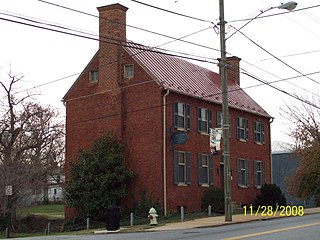
The Kentucky Hotel is a historic hotel building located at Lynchburg, Virginia. It is one of Lynchburg's three remaining early 19th century ordinaries. It was probably built before 1800, and is a 2 1⁄2-story structure of brick laid in Flemish bond. In about 1814, two side bays were completed, converting the house to a center hall plan.
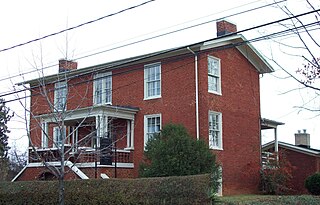
Centerview is a historic home located at Lynchburg, Virginia. It is a two-story brick house completed in 1871 in the Greek Revival style. The dependency, which is similar in construction and detail to the main house but which may date to 1861, is a one-stay gabled brick building and originally served as a summer kitchen and cook's dwelling among other functions. The house and dependency were rehabilitated in 1999-2000 as law offices. Robert Withers Morgan and his family were long resident in the house; one of his six children was the painter Georgia Weston Morgan, who resided there until 1923.

Miller–Claytor House is a historic home located at Riverside Park in Lynchburg, Virginia. It is a two-story, white framed structure, sheathed with beaded weatherboards. It is believed to be the fourth house erected in the new town in 1791, and is probably the oldest extant Lynchburg dwelling. In 1936, the imminent demolition of the house led to the formation of the Lynchburg Historical Society and the subsequent removal of the house to its present site.

Point of Honor is an historic home, now a city museum, located in Lynchburg, Virginia. The property has commanding views of the city and the James River.

Historic Sandusky is a historic home located in Lynchburg, Virginia. It is a formal two-story, brick "I" house built about 1808, with a later addition. It was built by Charles Johnston, and is one of the earliest homes in the Lynchburg area to display the architectural details and refinements characteristic of Federal design.

John Marshall Warwick House is a historic home located at Lynchburg, Virginia. It was built in 1826 by prominent Lynchburg tobacconist and city mayor (1833), John Marshall Warwick. It was one of the first houses to be built on the crest of Lynchburg Hill, later to be called Court House Hill, overlooking the James River. It exhibits the transition from the Federal to the Greek Revival styles. His grandson, United States Senator John Warwick Daniel was born in this home.

St. Paul's Church is a historic Episcopal church in Lynchburg, Virginia, United States.

The South River Friends Meetinghouse, or Quaker Meeting House, is a historic Friends meeting house located at Lynchburg, Virginia. It was completed in 1798. It is a rubble stone structure, approximately 30 by 51 feet, with walls 16 inches thick, and 12 feet high. The building ceased as a Quaker meeting house in the 1840s, and stands on the grounds of the Quaker Memorial Presbyterian Church. Adjacent to the structure is a historic graveyard. Buried there are Sarah Lynch and her son John, the founder of the city whose final resting place is marked by a plain Quaker stone and a modern plaque.
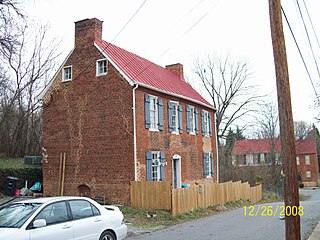
The William Phaup House is a historic home located in Lynchburg, Virginia. It is a modest two story, four bay Federal style brick dwelling constructed about 1817. It is named after the man who led its construction, William Phaup. Very few alterations have been made to the house since its construction.
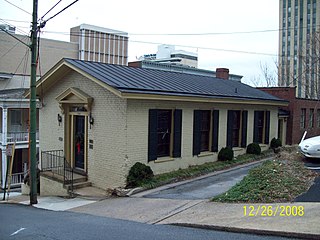
The Saint Paul's Vestry House is a historic building in Lynchburg, Virginia, United States. It was built about 1855 and is a single-story Classical Revival-style building with a simple low pitched gable roof and a rectangular plan. It is likely the only vestry house built exclusively for the governing body of an Episcopal Church in Virginia. It also served as the first home of the Lynchburg Woman's Club from 1903 to 1916.

The Court House Hill–Downtown Historic District is a national historic district located in Lynchburg, Virginia. The area is situated on a promontory overlooking the Lower Basin Historic District on the south bank of the James River. The approximately 50-acre (200,000 m2) district is composed of relatively intact city blocks of religious, commercial, residential, and governmental buildings and structures ranging in date from the early 19th century to the mid-20th century. Buildings in the district represent a variety of styles from the different periods, including the Federal, Greek Revival, Gothic Revival, Italianate, Queen Anne, Neoclassical, Italian Renaissance, Spanish Eclectic, Craftsman, and Art Deco styles.

The Lynchburg Courthouse is a historic courthouse building located at Lynchburg, Virginia. Built in 1855, it occupies a prominent position overlooking the steeply descending steps of Monument Terrace. The building is executed in stucco-over-brick on a granite ashlar basement and is an example of the Greek Revival. The building is capped by a shallow dome located over the intersection of the ridges. At the top of the dome is a small open belfry consisting of a circle of small Ionic columns supporting a hemispherical dome. The front of the court house has a three-bay Doric portico.

Bon Aire is a historic home located near Shipman, Nelson County, Virginia. It is a Federal-style brick dwelling dramatically sited on a hill overlooking the James River. It was built about 1812 in a three-part scheme; with a two-story center section flanked by 1 1⁄2-story, two-bay wings. In plan and detail Bon Aire is linked to a number of tripartite houses, such as Point of Honor in nearby Lynchburg, built for a cousin of Bon Aire's builder, Dr. George Cabell.
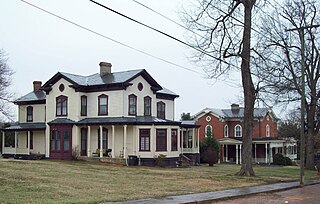
The Daniel's Hill Historic District is a national historic district located in Lynchburg, Virginia.

The Federal Hill Historic District is a national historic district located in Lynchburg, Virginia. The district includes some one dozen residential blocks in the heart of Lynchburg spread over 33 acres (130,000 m2). The district's architecture consists primarily of free-standing brick or frame houses in a variety of styles but of harmonious scale. Included are three important French Second Empire houses standing near one another on Harrison Street. There is also a notable assemblage of free-standing dwellings in architectural styles ranging in date from the early 19th century through the Edwardian styles of the early 20th century. There is an important collection of early Federal-style townhouses.
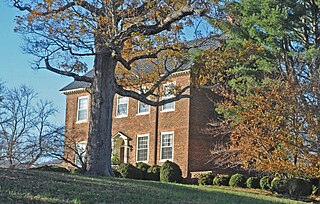
Fancy Farm is a historic plantation house located at Kelso Mill, near Bedford, Bedford County, Virginia. It was built about 1785, and is a two-story, five bay brick dwelling in the Late Georgian style. It has a metal gable roof and two interior end chimneys. The interior features original woodwork. The house was restored in 1969-1971. Also on the property are a contributing brick storehouse, a frame kitchen with a stone chimney, and a frame quarters also with a stone chimney. The property features a panorama of the Peaks of Otter. Fancy Farm was used as the headquarters of Union General David Hunter in his Lynchburg campaign during the Valley Campaigns of 1864.

Walnut Hill is a historic home located near Lynchburg, Campbell County, Virginia. The 1 1/2-story dwelling was built in several sections starting in 1802. The oldest section is a log dwelling with an internal gable-end stone chimney, and is now the south wing. Before 1820, a two-room-plan frame addition was built onto the north end of the log dwelling to become the main or front section of the house. One-story frame additions were made about 1870, in 1948-1950, and again in 1984. Also on the property are a contributing smokehouse, chicken house, kitchen chimney, and family cemetery.

Pleasant Grove, also known as Joseph Deyerle House, Deyerle Homeplace, and Glenvar is a historic home located near Salem in Roanoke County, Virginia. It was built in 1853, and is a two-story, three-bay, Greek Revival style brick dwelling. The front facade features a well-proportioned Ionic order portico with slender tapered, fluted columns. It also has an original sunroom measuring 7 feet by 14 feet. Also on the property are the contributing kitchen, spring house, smokehouse, servant's house, and privy.
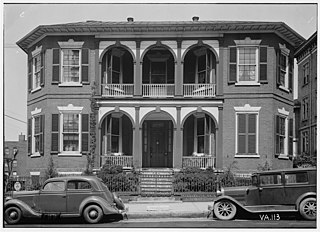
Hancock–Wirt–Caskie House, also known as The William Wirt House, is a historic home located in Richmond, Virginia. It was built in 1808–09, and is a two-story, seven-bay Federal-era brick dwelling with a hipped roof. The three bays on either side of the entrance are formed into octagonal-ended or three-sectioned bow front projections with a wooden, two-level porch arcade screening the central space. It has a central hall plan with an octagonal room on the south and a rectangular room behind and a larger single room across the hall. In 1816, William Wirt (1772–1834) purchased the house and lived there until 1818, when he moved to Washington as Attorney General of the United States under James Monroe. Formerly serving as the headquarters of the Richmond Chapter of the American Red Cross, the house is now a private residence. The last business to occupy this house was the law firm of Bowles and Bowles. The house bears a strong resemblance to Point of Honor in Lynchburg, Virginia.


























